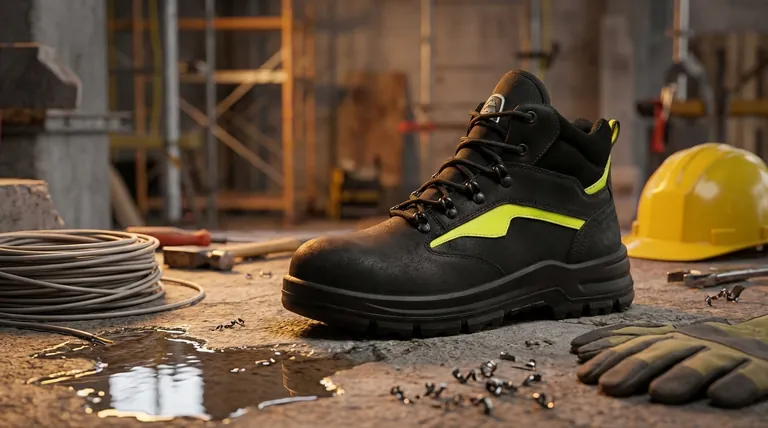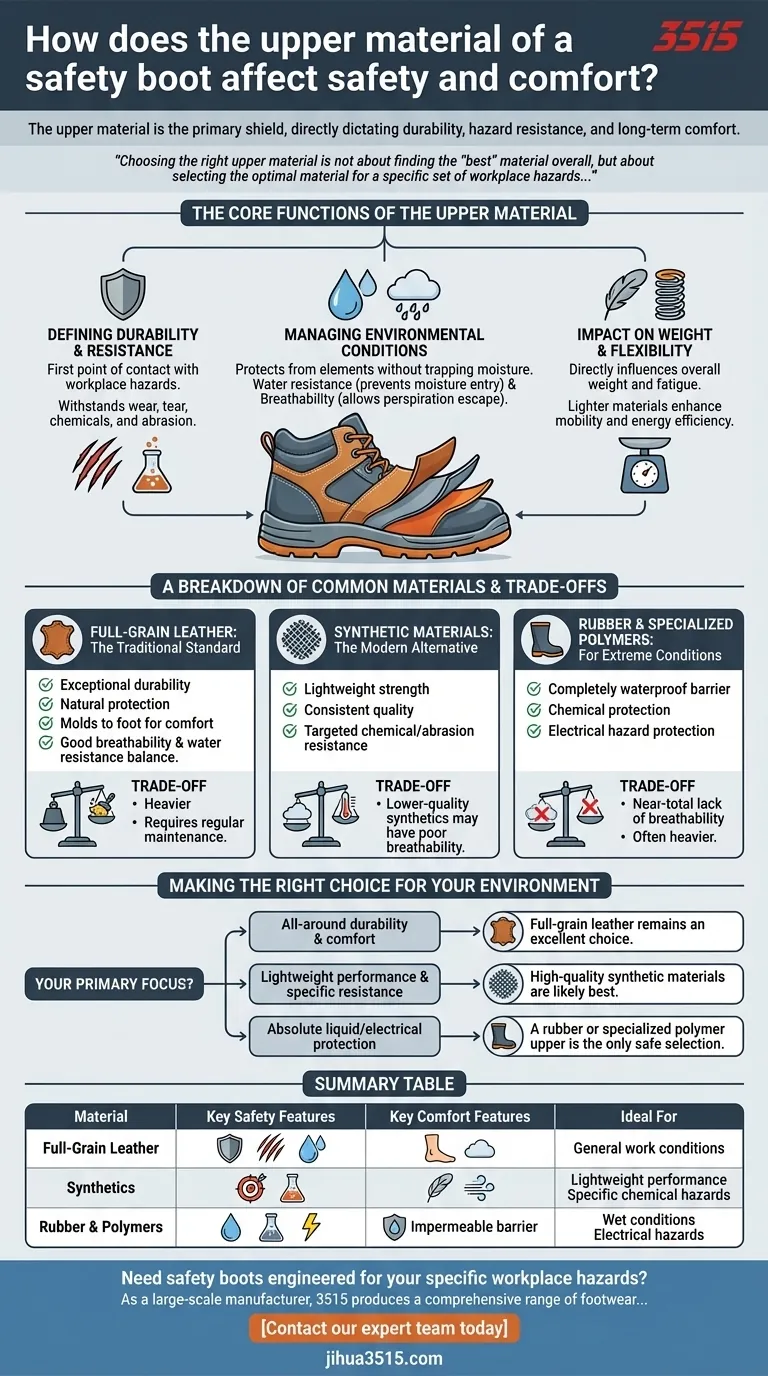The upper material of a safety boot is its primary shield, directly dictating its performance in durability, resistance to hazards, and long-term comfort. This single component determines how well the boot protects you from chemicals and abrasions, keeps your feet dry, and how much fatigue you feel at the end of a demanding day.
Choosing the right upper material is not about finding the "best" material overall, but about selecting the optimal material for a specific set of workplace hazards, balancing targeted protection with all-day comfort and mobility.

The Core Functions of the Upper Material
The upper is more than just the "skin" of the boot; it’s an engineered system that serves critical functions for both safety and wearer well-being.
Defining Durability and Resistance
The upper is the first point of contact with workplace hazards. Its ability to withstand wear and tear is fundamental to safety.
Materials like full-grain leather offer excellent natural durability and tear resistance. Modern synthetic materials like microfibre or TPU are engineered specifically for high abrasion and chemical resistance.
Managing Environmental Conditions
An effective upper must protect you from the elements without trapping moisture.
Water resistance is a key feature that prevents moisture from entering the boot, crucial for comfort and foot health. Equally important is breathability, which allows perspiration to escape, reducing fatigue and the risk of blisters.
Impact on Weight and Flexibility
The material choice directly influences the boot's overall weight. A heavier boot can contribute significantly to foot fatigue over a long shift.
Lighter materials, often synthetics, can enhance mobility and reduce the energy required for each step, leading to greater comfort and efficiency.
A Breakdown of Common Upper Materials
Different materials are chosen to meet the demands of different environments. Understanding their core properties is key to making an informed choice.
Full-Grain Leather: The Traditional Standard
Leather is valued for its exceptional durability, natural protective qualities, and ability to mold to the wearer's foot over time for a comfortable fit.
It offers a high degree of tear resistance and provides a good balance of breathability and water resistance, making it a versatile choice for many general work conditions.
Synthetic Materials: The Modern Alternative
This category includes materials like microfibre and Thermoplastic Polyurethane (TPU). These are engineered to provide specific performance advantages.
Synthetics often excel in providing lightweight strength, consistent quality, and targeted resistance to specific chemicals or abrasion, sometimes surpassing natural leather in these areas.
Rubber & Specialized Polymers: For Extreme Conditions
For work environments with significant exposure to water, mud, chemicals, or electrical hazards, rubber uppers are essential.
These materials provide a completely waterproof barrier. Their non-conductive properties also make them indispensable for protecting against electrical risks.
Understanding the Trade-offs
No single material is perfect for every application. The right choice always involves balancing strengths and weaknesses.
Leather: Protection vs. Maintenance
High-quality leather offers unmatched durability and comfort once broken in. However, it is typically heavier than synthetics and requires regular cleaning and conditioning to maintain its protective properties.
Synthetics: Lightweight vs. Breathability
Synthetic uppers provide excellent lightweight performance and can be engineered for specific resistances. However, lower-quality synthetics may offer poor breathability, leading to discomfort in warm conditions.
Rubber: Impermeable vs. Comfort
Rubber is unbeatable for waterproofing and chemical protection. Its primary trade-off is a near-total lack of breathability, which can make it uncomfortable for all-day wear, and it is often heavier than other options.
Making the Right Choice for Your Environment
Your specific workplace hazards should be the ultimate guide in selecting an upper material.
- If your primary focus is all-around durability and comfort in varied conditions: Full-grain leather remains an excellent and reliable choice.
- If your primary focus is lightweight performance and resistance to specific chemicals or abrasions: High-quality synthetic materials are likely your best option.
- If your primary focus is absolute protection from liquids or electrical hazards: A rubber or specialized polymer upper is the only appropriate and safe selection.
Ultimately, selecting the correct upper material is a critical decision for your daily safety and long-term well-being on the job.
Summary Table:
| Material | Key Safety Features | Key Comfort Features | Ideal For |
|---|---|---|---|
| Full-Grain Leather | High durability, tear resistance, good water resistance | Molds to foot, good breathability | General work conditions, varied environments |
| Synthetics (Microfibre, TPU) | Targeted chemical/abrasion resistance, lightweight | Lightweight, enhances mobility | Lightweight performance, specific chemical hazards |
| Rubber & Polymers | Waterproof, chemical protection, electrical hazard protection | Impermeable barrier | Wet conditions, electrical hazards, extreme chemical exposure |
Need safety boots engineered for your specific workplace hazards?
As a large-scale manufacturer, 3515 produces a comprehensive range of footwear for distributors, brand owners, and bulk clients. Our production capabilities encompass all types of safety shoes and boots, ensuring the perfect balance of protection and comfort for your workforce.
Contact our expert team today to discuss your requirements and discover how we can provide durable, comfortable, and compliant safety footwear for your business.
Visual Guide

Related Products
- Wholesale Premium Waterproof Nubuck Safety Shoes Boots
- Premium Sport Style Safety Boots for Bulk Orders
- Heavy Duty Nubuck Safety Boots Safety Shoes for Global Distribution
- Premium Flame-Retardant Waterproof Safety Boots and Shoes
- Advanced KPU Athletic Safety Shoe with Steel Toe Cap Anti-Slip Rotary Lacing System
People Also Ask
- What are the key safety features to consider when choosing work boots? Ensure Maximum Protection for Your Job
- What are the advantages and disadvantages of steel toe boots? A Guide to Maximum Protection vs. Comfort
- What does the infographic mentioned in the article cover? Prevent Workplace Foot Injuries with the Right Safety Footwear
- What is the importance of wearing safety shoes in the workplace? Protect Your Team and Your Bottom Line
- What safety boots are recommended for the manufacturing industry? Ensure Complete Protection & Comfort



















